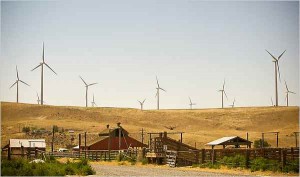A recent article in the New York Times focuses on the financial benefits coming into communities in eastern Oregon, where wind energy development is booming despite state noise limits of 36dB at homes. Most wind farms in the US and Canada face noise limits in the 45-50dB range, with some regs going as low as 40dB at night; wind industry representatives generally claim that lower noise limits will preclude wind development. Oregon’s approach to wind farm siting, which imposes a cautionary noise limit to protect residents from unwanted noise, while allowing for easy exemptions when residents are willing to live closer to turbines, appears to AEI to be a constructive response that addresses concerns about protecting the rural soundscape while also encouraging wind development.
In Sherman County, landowners earn $5500 per year per turbine, often hosting ten or more per landowner, often in wheat fields. The County earns enough in taxes and fees to keep schools flush with cash, and issue a modest annual check to all heads of household.
While a 36dB noise limit aims to keep audible turbine noise close enough to existing quietest background ambient levels to be relatively unobtrusive, it should be noted that some residents report noise levels well above 36dB at times, suggesting that the noise modeling used in laying out the wind farms may have been faulty. Apparently, even with the lower noise limits, some homes are within a half mile of turbines, a range in which turbines are often easily audible and can sometimes cause sleep disruption. The state law allows companies to obtain waivers from residents in order to build closer and create to noise levels over 36dB, and some wind companies are seeking such waivers from nearby neighbors, in exchange for one-time or recurring payments. These waivers could also protect companies from situations in which actual noise levels rise slightly above the levels predicted by pre-construction noise models, as recently occurred at the Willow Creek Wind Farm in the same region.

